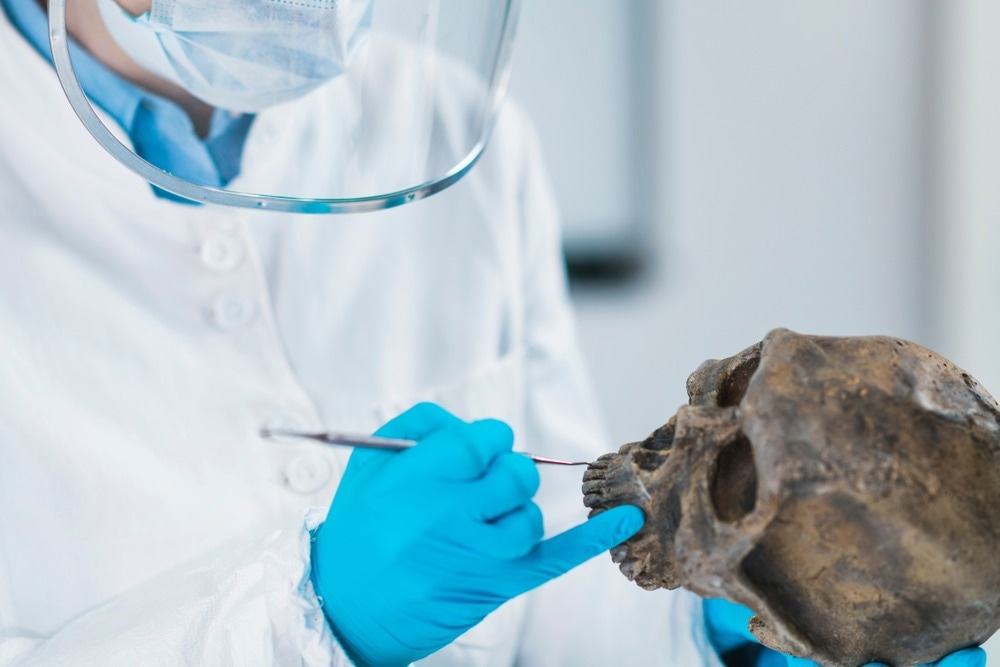The Eastern Mediterranean and Near East regions experienced significant societal changes during the late 3rd millennium Before Common Era (BCE).
Recent archaeological studies strongly indicate the influence of prior infectious diseases on societal trajectories. For example, the incidence of Yersinia pestis, which causes the plague, and Salmonella enterica, which causes typhoid/enteric fever, was responsible for the most destructive historic pandemics.

Study: Ancient Yersinia pestis and Salmonella enterica genomes from Bronze Age Crete. Image Credit: Microgen / Shutterstock.com
In a recent Current Biology study, researchers utilize genomic sequencing data of these two pathogens from the Bronze Age to elucidate the importance of including past infectious outbreaks as a contributing factor to societal changes.
Background
From the Late Neolithic period in the 4th millennium BCE to the Middle Minoan II period in the 18th century BCE, the Hagios Charalambos cave was used as a secondary burial site. This cave is situated on the Lasithi plateau of Crete, Greece, and contains the largest depositions of deceased humans. Notably, Hagios Charalambos has been found to preserve ancient DNA (aDNA) of humans, likely because of its low and stable temperatures.
Osteological analyses have identified several pathologies of individuals buried in the Hagios Charalambos cave. Each of these diseases could be diagnosed by visual inspection of the remains, as they did not exhibit any traces of lesions that could have suggested acute infection.
In archaeological studies, dental analyses play an important role in the detection of blood-borne pathogens.
About the study
To identify pathogens that prevailed during the Bronze Age and how they affected early societies in Crete, 68 human teeth from the Hagios Charalambos cave were analyzed. Based on the anthropological assessment, the selected specimens represented a minimum of thirty-two individuals. These teeth were either found loose or attached to bone fragments.
DNA was extracted from all teeth samples, with subsequent analysis revealing that human DNA preservation ranged between 0.1% to 34%. Traces of aDNA from a variety of common oral bacteria, such as Porphyromonas gingivalis, Treponema denticula, and Tannerella forsythia were detected. A typical aDNA damage pattern was observed in the form of C to T substitution.
The DNA of Y. pestis and Salmonella enterica was detected in four individuals. The whole genome of both pathogens was sequenced, which was followed by a maximum likelihood (ML) phylogeny analysis of the modern and ancient S. enterica and Y. pestis genomes.
Study findings
The study findings were consistent with previous studies that utilized other ancient genomes of the Late Neolithic Bronze Age (LNBA) lineage and revealed the absence of the ymt gene on the pMT1 plasmid. Active forms of the genes PDE-2, PDE-3, rscA, ureD, and flhD were also identified.
All modern Y. pestis genomes, except the LNBA and Middle Neolithic lineages, showed insertions or nonsense mutations of previously activated genes. Another important evolutionary change of Y. pestis was the addition of the ymt gene, which enabled its adaptation to the flea vector.
The mode of transmission of Y. pestis in their initial phase of evolution was not determined. Nevertheless, it was hypothesized that Y. pestis transmitted across Eurasia following human migration from the Eurasian steppe.
This hypothesis was supported by studies related to all LNBA individuals, from whom ancient Y. pestis genomes were isolated. The genomic analysis also suggested that the transmission of this pathogen occurred in the same direction.
The presence of unique single nucleotide polymorphisms (SNPs) suggested two distinctly different strains that infected two different individuals. For specimens HGC009 and HGC040, a principal component analysis (PCA) was performed using modern West Eurasian populations. To this end, PCA analysis showed a shift from the cluster of Greek Neolithic genomes in the direction of Chalcolithic-Bronze Age Anatolia.
Genetic analysis data suggested that the individuals whose samples were used in the current study were likely to be inhabitants of Crete at the end of the 3rd millennium BCE. An important aspect of this period was that it witnessed many transformations across the Eastern Mediterranean, including the Egyptian Old Kingdom and Near Eastern Akkadian State, which were primarily explained due to drastic climatic changes.
In Crete, no distinctive crisis was reported at the end of the Early Minoan II period. Furthermore, the transition between the Early Minoan III and Middle Minoan IA periods did not reveal any distinctive environmental factors that contributed to the transition. These periods were important due to the emergence of Old Palaces during Middle Minoan IB.
Based on genetic analysis of specimens obtained from Hagios Charalambos, it could be inferred that Y. pestis and S. enterica subsp. S enterica could have caused epidemics in the human population that caused the transition. However, the virulence and transmission route of these pathogens remains unclear.
Conclusions
In the future, screening for more pathogens from other samples obtained from the Hagios Charalambos cave is needed. This could provide more conclusive information on the impact of infectious diseases during the end of the 3rd millennium BCE.
The current study has strongly indicated the presence of Y. pestis and S. enterica on the island of Crete, with wide distribution in Eurasia during the same period. Circulation of Y. pestis and S. enterica in neighboring areas further emphasizes that infectious pathogens have the potential to contribute solely to societal changes.
Journal reference:
- Neumann, U. G., Skourtanioti, E., Burri, M., et al. (2022) Ancient Yersinia pestis and Salmonella enterica genomes from Bronze Age Crete. Current Biology. doi:10.1016/j.cub.2022.06.094